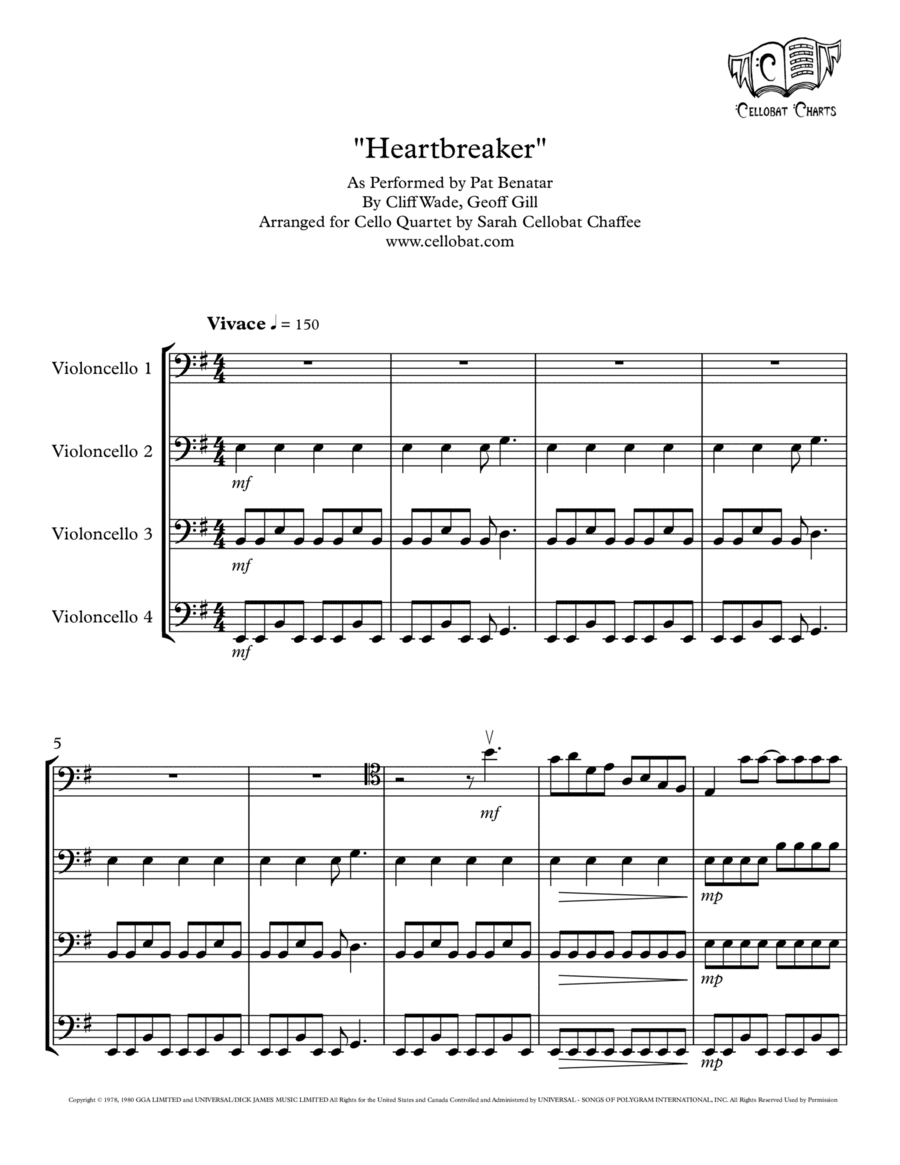String Ensemble Cello - Level 4 - Digital Download SKU: A0.1250783 By Pat Benatar. By Cliff Wade and Geoff Gill. Arranged by Sarah Cellobat Chaffee. Contemporary,Film/TV,Pop,Rock,Video Game. 27 pages. Sarah Cellobat Chaffee #845047. Published by Sarah Cellobat Chaffee (A0.1250783). *INSTRUMENTATION: 4 CELLOS*Heartbreaker, one of the most iconic songs in female rock history, was released by Pat Benatar as a single from her debut album in 1978. Originally released by an English singer named Jenny Darren, Benatar's cover proved to be her breakthrough song; it topped the Billboard charts for nearly 5 weeks and was ultimately named one of VH1's 100 best hard rock songs of all time. It has since been featured in video games, movies, TV shows, movies, and has generally become a staple of pop culture -- and now you can rock out on it with your cello buddies! This Cellobat arrangement for cello quartet is just as hard-hitting as the original, with epic vocal lines, powerful harmonies, a driving rock beat, and even a fun guitar solo. I guarantee your group will have a blast! Rated advanced-intermediate for tenor/treble clef and basic thumb position in some of the parts; this will be learnable for students and easily sightreadable for professionals.Why choose Cellobat Charts arrangements? For any musician who knows what they're doing, the answer is easy: just listen to them. Every freelance musician has thrown hard-earned money away on questionable, error-filled charts by unknown arrangers from weird corners of the Internet. But watch out -- inferior arrangements not only make gigs less enjoyable to play, but they also make your group sound bad to your client and audience, no matter how great your players really are. That's why Cellobat Charts is here: to provide students and working string players alike with high-quality versions of highly requested music. My arrangements are guaranteed to be energetic, fun to play, and enjoyable to listen to, whether or not you're familiar with the original songs. Hear the difference for yourself! Full videos of many Cellobat Charts arrangements are available on YouTube so you know exactly what you're getting. Click Watch near the item details at the top of the page for full video of Heartbreaker. Crowd pleasing guaranteed.Sarah âCellobatâ Chaffee is an in-demand acoustic & electric cellist and string arranger. Currently, she performs with legendary rock band Aerosmith in their âDeuces Are Wildâ residency show, and she is the principal cellist for the Raiders House Band, playing for a crowd of 60,000 at all of the team's home games. She also plays with many other groups including Premiere Wedding Music, Bella Electric Strings, the Femmes Of Rock, and David Perricoâs Pop Strings Orchestra. Sarah has performed and recorded with numerous other artists including Disturbed, Mötley Crüe, Celine Dion, Halsey, Michael Bublé, Sarah Brightman, and Lady A. She is the exclusive arranger for a number of award-winning wedding and event companies all across the United States, including Premiere Wedding Music, Las Vegas Music Oasis, and Impulse Strings, and she has created custom arrangements for many other ensembles all over the world. You can find her at:http://www.cellobat.comhttp://www.instagram.com/cellobathttps://www.youtube.com/@Cellobat.
